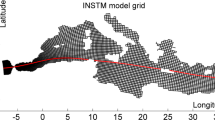Abstract.
The Baltic Sea ice season under changing climate conditions is investigated using a 3D coupled ice–ocean model. Results of multi-year simulations for the period of May 1980 to December 1993 are compared with observations from monitoring stations, ice charts and satellite data. The period 1980–1993 has been selected mainly because of the availability of homogeneous observational data sets for atmospheric variables and river runoff with sufficient quality to force a 3D high resolution Baltic Sea model. The observed seasonal variation of sea ice is well reproduced by the model. Furthermore, two sets of 9-year time slice experiments have been performed using results of an atmospheric regional climate model as forcing, one representing pre-industrial greenhouse conditions (control simulation), and the other a global warming with a 150% increase of equivalent CO2 concentration (scenario simulation). At the lateral boundaries of the regional climate model, results of the global atmosphere–ocean general circulation model HadCM2 have been prescribed. In the control run, the mean seasonal cycle of ice cover and its variability is simulated realistically compared to observations, but the seasonal ice cover maximum is shifted in time by about 18 days and the simulated mean melting date is delayed. Mild winters are missing in the relatively short control run. The decrease of mean ice extent in the scenario, compared to the control run, is dramatic, reducing from 210 · 109 m2 to 82 · 109 m2 (a relative change of 61%). However, in all scenario years, ice is still formed in the northernmost basin of the Baltic Sea, the Bothnian Bay. The minimum ice extent is 16 · 109 m2 (for comparison: the area of the Bothnian Bay is about twice as large). The mean number of ice days decreases significantly. In the fast ice zone of the Bothnian Bay the mean ice season is reduced by 40 days. The ice in the scenario run is thinner with less snow on top. In the central Bothnian Bay, mean maximum annual ice thickness is reduced by 25 cm from 54 to 29 cm. Model dependent uncertainties are discussed.
Similar content being viewed by others
Author information
Authors and Affiliations
Additional information
Electronic Publication
Rights and permissions
About this article
Cite this article
Meier, .H. Regional ocean climate simulations with a 3D ice–ocean model for the Baltic Sea. Part 2: results for sea ice. Climate Dynamics 19, 255–266 (2002). https://doi.org/10.1007/s00382-001-0225-5
Received:
Accepted:
Issue Date:
DOI: https://doi.org/10.1007/s00382-001-0225-5




